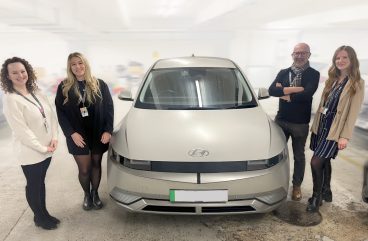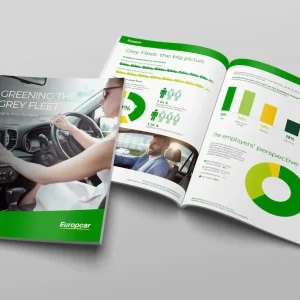
Located in the heart of East Anglia, The Flagship Group is a social housing company driven by a bold mission: to end the housing crisis in the East of England.
With unwavering dedication to building, improving and safeguarding homes, the non-profit prioritises financial responsibility while placing employees at the forefront. Its charity, Hopestead, dedicated to homelessness relief, enjoys robust support from the company, forging a strong link between their initiatives.
Flagship Group’s well-maintained vehicle fleet plays a crucial role in the company’s mission, ensuring that teams can efficiently manage and maintain properties across the region.
Heading it up is Catherine South, who assumed her current position two years ago, which uniquely combines her proficiency in payroll management with a newfound responsibility of overseeing fleet operations.
South explains that the company hasn’t yet expanded to the point of having a specialised fleet department, which is why in addition to her monthly payroll responsibilities she takes on the role of fleet management. “When I first started, I had zero knowledge about fleet management but plenty about payroll,” she shares.
“I had to quickly immerse myself in learning about cars. Fortunately, with the support of my manager and a team of two administrators, we faced the challenge together. It was a steep learning curve, but now I feel confident in my abilities.”
For South and her employees, working for Flagship Group is more than just a job; it’s about making a tangible difference in people’s lives. “In our dynamic departments, dedicated efforts are underway to tackle the housing crisis head-on,” remarks South.
The fleet is diverse, comprising approximately 280 cars and 30 vans, alongside the Flagship Services Fleet, a separate division consisting of around 400 vans.
The payroll and fleet department being grouped together is unique, and South explains that unlike traditional fleet departments, Flagship Group’s model fosters accessibility and responsiveness to employee inquiries. South says: “The way I see it is HR, payroll and fleet are all services you offer your employees, so grouping them together makes a lot of sense.
“When someone needs information about their company car expenses, they can easily approach us in the office. We can provide them with all the necessary details without the hassle of going back and forth between fleet and payroll,” explains South.
This unique integration of two departments has another specific benefit too. South considers it instrumental in achieving the fleet’s goal of carbon neutrality by 2027. “Electrification has given us a good direction to move towards,” she says. “It’s a significant selling point for electric vehicles when we can inform individuals that their company car tax will only be 2%, increasing by just 1% the following year. Having all this information readily available in one place is really beneficial to the company and drivers,” South adds.
With cars leased for four years, the company has now shifted the order book entirely to electric vehicles, and is able to do so due to their range meeting the requirements of its fleet drivers, which consist of housing officers visiting tenants, operational managers, team leaders, or heads of service.
In each of these positions, South says that staff members have the opportunity to lease a quality vehicle from a diverse range of options. Granting drivers the autonomy to select their own vehicle is a job perk that South is fond of. “As long as it’s electric, their choices are virtually unlimited,” she remarks.“Whether they prefer larger vehicles or wish to make contributions towards their car, we accommodate their preferences,” she says. “People have their favourite brands and we like people to be comfortable and happy in what they drive.” Some electric vehicles offered to drivers include the Nissan Ariya, Kia e-Niro, and Vauxhall Mokka, whereas plug-in hybrids are being slowly phased out.
Leading the charge
To support its electric car drivers, the company provides charging infrastructure at its five primary flagship offices, with chargers installed at three of them through a partnership with Mer UK. Additionally, some of the company’s smaller offices have individual chargers. “We are actively expanding and maintaining this network, aiming to integrate into a broader charging network,” notes South. “Addressing logistical concerns such as security and access to car parks is underway, and we’re exploring collaborations with local companies and government bodies to facilitate this process.”
The company extends support to drivers by facilitating home charging through a partnership with Pod Point, subsidising up to £850 for a home charger installation for its essential users. While its perk car drivers still receive a discount from Pod Point, they are responsible for covering the full cost. South says: “To ease the financial burden, we offer the option to pay upfront or spread the cost over 12 months through a payment plan.”
South says Pod Point’s affiliation with EDF proves advantageous for the fleet, particularly for drivers living in flats where installation complexities arise. “PodPoint conducts surveys and provides tailored advice to our drivers, leveraging their expertise as an energy company to optimise our charging solutions.”
According to South, the feedback from drivers regarding electric cars has largely been positive. However, as with any new initiative, challenges are inevitable. From her experience of introducing electric cars to the fleet drivers, South says around half of the drivers have been initially receptive to getting an electric car right away, half have some questions, and around 15% are initially less enthusiastic.
South understands that change can be daunting, and some individuals have been resistant. “We encounter drivers who have never operated an automatic vehicle before, and the concept of electric power adds another layer of adjustment,” she explains.
The team initiates conversations with the drivers, willing to make exceptions if they can’t install a home charger due to living circumstances like living in a flat. Yet, once the drivers experience driving an electric vehicle firsthand and understand its simplicity, South says any apprehensions usually dissipate. “Once people drive an EV and realise how easy it is, half the battle is won. We keep a few demo cars on hand for trials, and often it’s just a matter of encouraging someone to get behind the wheel. The typical reaction is surprise and excitement,” South continues.
By showcasing the practicality, cost-effectiveness, and environmental advantages, the company has successfully transitioned most drivers to electric vehicles, with plug-in hybrids as an option for those hesitant or unable to switch immediately. “We can offer existing plug-in hybrid vehicles from the fleet and typically reassess within a year,” South explains. “It’s an incremental process supported by open-minded employees. Our approach involves open discussions, highlighting practicalities such as nearby charging points, and emphasising that finding solutions is a collaborative effort.”
Since starting in her role two years ago, South says the company has encountered various challenges beyond just electrification, including the repercussions of Brexit, the pandemic, rising living costs, and global conflicts. “At one point, our lead time for new car orders stretched from the usual six months to a staggering 18 months due to parts shortages, causing significant strain. Consequently, we relied heavily on hire vehicles, exacerbating the situation. However, we’re seeing improvements now, and we’re hopeful for smoother operations moving forward.”
Keeping drivers safe
Although a big focus of South’s has been electrification since starting in her role, she also has placed driver safety as a priority. Even though the fleet hasn’t implemented dashcams yet, South mentions they have explored the possibility. “Having dashcams as a safety measure could provide evidence in case of accidents, protecting our drivers. This is something we’re considering for the future, purely for driver safety, not to monitor their every move.”
The fleet already checks the licences of its drivers through Davis and has an internal health and safety team that offers online driver training to its company car drivers, so South believes that is sufficient to keep them safe. “At the end of the day, we have a responsibility to ensure our drivers are safe and that their vehicles are legal, must adhere to the law, and while we can provide resources and support, they are ultimately responsible for their behaviour on the road,” says South. Recently, her team discussed the implications of enforcing speed limits and concluded that it’s not their place to reprimand drivers for legal violations – “that’s the law’s job,” she explains. “Our role is to ensure vehicles are safe and legal and to offer support and resources.”
The country aims to reach its electric vehicle goals by 2035, although South wants to achieve it by 2027. But this ambitious target introduces risks, as the costs and durability of new technologies are uncertain. South believes that considering the longevity of electric car batteries is crucial for the fleet’s future. “We’ve shifted from contract purchasing fuel cars to buying them at the end of their contracts and selling them for a profit, which is a great way to use our funds wisely,” she notes.
However, all of the fleet’s PHEVs and EVs are on contract hire, so they will be returned to the leasing company at the end of the lease. “This approach mitigates the risk, as we are unsure how these cars will hold up, the cost of battery replacement, and other long-term factors,” South explains.
She adds: “Moving to contract hire alleviates the pressure of owning cars that might devalue or become difficult to resell. In a few years, we might face challenges with lower-mileage vehicles and their roadworthiness, similar to all new cars. Adapting to new technologies and the accompanying challenges is part of our ongoing strategy.”
Another priority for South’s team is ensuring everyone drives a car they enjoy. “It’s a pleasure to provide someone with a nice new car, especially for new starters who all receive a brand new vehicle unless they opt for an existing one from the fleet,” South says. Many employees have never driven a brand-new vehicle before, making it a special experience. “Our goal is to make sure everyone is happy, feels heard, and has all the options available to them. We strive to help them get the best vehicle possible.”
When it comes to value, the company listens to its employees’ preferences. “If someone is passionate about cars or has a favourite brand, we do our best to accommodate their choices while considering costs,” South adds. “We treat everyone equally, ensuring that regardless of their position within the company, they receive the same level of respect and opportunities. While some roles may have different cost allocations, our commitment to providing equal opportunities remains unwavering.”
By prioritising driver safety, vehicle satisfaction, and environmental responsibility, South and her team have created a fleet that balances practicality with innovation. This holistic approach ensures that Flagship Group remains a leader in both employee satisfaction and sustainability within the social housing sector.





